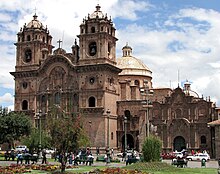Cusco /ˈkuːzkoʊ/, often spelled Cuzco (Spanish: Cuzco, [ˈkusko]; Quechua: Qusqu or Qosqo,IPA: [ˈqɔsqɔ]), is a city in southeastern Peru, near the Urubamba Valley of the Andes mountain range. It is the capital of the Cusco Region as well as the Cuzco Province. In 2007, the city had a population of 358,935. Located on the eastern end of the Knot of Cuzco, its elevation is around 3,400 m (11,200 ft).
Cusco was the site of the historic capital of the Inca Empire and was declared a World Heritage Site in 1983 by UNESCO. It is a major tourist destination and receives almost 2 million visitors a year. It is designated as the Historical Capital of Peru by the Constitution of Peru.[1]
Cusco was the capital of the Inca Empire (13th century-1532). Many believe that the city was planned as an effigy in the shape of a puma, a sacredanimal.[11] Under the Inca, the city had two sectors: the urin and hanan.
After Peru declared its independence in 1821, Cusco maintained its importance within the administrative structure of the country. Upon independence, the government created the Department of Cuzco, maintaining authority over territory extending to the Brazilian border. Cusco was made capital of the department; subsequently it became the most important city in the south-eastern Andean region.
At the beginning of the 20th century, the city's urban sprawl spread to the neighboring districts of Santiago and Wanchaq.
In 1911, explorer Hiram Bingham used the city as a base for the expedition in which he rediscovered the ruins of Machu Picchu.
A 1950 earthquake shook the city, causing the destruction of more than one third of the city's structures. Later, the city began to establish itself as a focal point for tourism and began to receive a greater number of tourists.
Since the 1990s, tourism has increased. Currently, Cusco is the most important tourist destination in Peru. Under the administration of mayor Daniel Estrada Pérez, a staunch supporter of the Academia Mayor de la Lengua Quechua, between 1983 and 1995 the Quechua name Qosqo was officially adopted for the city.
Centro Artesanal Cusco - Craft Market
Until the late 18th century Cusco was the most populous city in the continent, even more than Lima. But because of the great revolution of Túpac Amaru II in 1780, the white population migrated to Arequipa, considered safer from a possible new uprising. So, until the 20th century, the population was largely mestizo and indigenous, but now the white population has grown significantly in the city as high as 30%, as it is experiencing a demographic explosion process led by the tourism boom.
The city has a population of 358,935 people in 2007 according to INEI and ca. 510,000 people by 2009.
The first cathedral built in Cusco is the Iglesia del Triunfo, built in 1539 on the foundations of the Palace of Viracocha Inca. Today, this church is an auxiliary chapel of the Cathedral.
The main basilica cathedral of the city was built between 1560 and 1664. Stone was used as the main material, which was extracted from nearby quarries, although some blocks of red granite were taken from the fortress of Saksaywaman.
This great cathedral presents late-Gothic, Baroque, and plateresque interiors and has one of the most outstanding examples of colonial goldwork. Its carved wooden altars are also important.
The city developed a distinctive style of painting known as the "Cuzco School", and the cathedral houses a major collection of local artists of the time. The cathedral is known for a Cusco School painting of the Last Supper depicting Jesus and the twelve apostles feasting on guinea pig, a traditional Andean delicacy.
The cathedral is the seat of the Archdiocese of Cuzco.
Iglesia de la Compañía de Jesus[edit]
This church (Church of the Society of Jesus), whose construction was initiated by the Jesuits in 1576 on the foundations of the Amarucancha or the palace of the Inca ruler Wayna Qhapaq, is considered one of the best examples of colonial baroque style in the Americas.
Its façade is carved in stone and its main altar is made of carved wood covered with gold leaf. It was built over an underground chapel and has a valuable collection of colonial paintings of the Cusco School.











































No comments:
Post a Comment